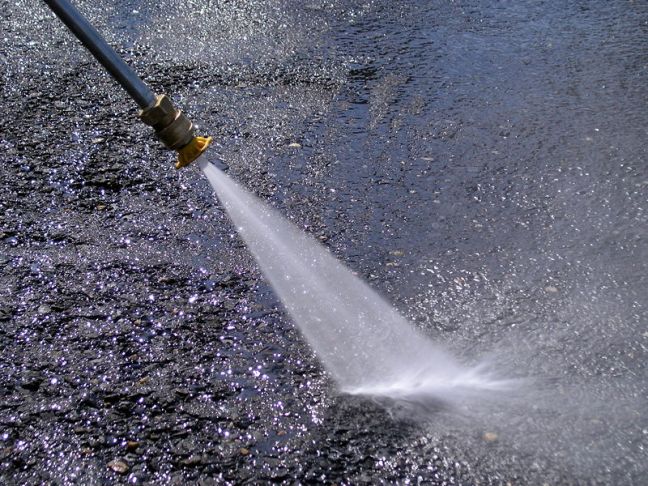Efficient Oil Stain Removal in Strongsville for Clean, Spotless Driveways
Wiki Article
Basic Actions for Effective Oil Stain Removal From Car Surfaces
Efficient oil stain removal from car surfaces is critical for keeping both looks and value. Comprehending the type of tarnish and the product impacted can significantly affect the cleansing procedure. By using the right methods and supplies, one can attain sufficient outcomes without jeopardizing the integrity of the vehicle's surface.Evaluating the Spot Type
When taking on oil discolor removal from cars, it is important to very first assess the kind of stain existing. Oil spots can vary considerably based upon their beginning, age, and the surface they have permeated. Typical sources of oil discolorations consist of engine oil, transmission liquid, and even cooking oil, each having unique features that affect the elimination process.
In addition, consider the area of the stain. Strongsville Fleet Washing. Discolorations near the engine area may show a leakage, while those beneath the vehicle can result from drips or spills. By properly recognizing the discolor's beginning and problem, car owners can select the most reliable removal methods, guaranteeing successful outcomes without triggering more damage
Celebration Necessary Products
Planning for oil tarnish elimination involves gathering the necessary supplies to guarantee a effective and safe cleaning procedure. The right devices and materials can make the difference in between an effective result and further damage to your car's surface area.
Begin by acquiring absorptive materials such as paper towels or cloths, which will assist in blotting up excess oil. Dish soap thinned down in warm water can serve as a gentle option for lighter stains.
A soft-bristle brush or sponge will certainly be essential for applying the cleaning remedy without scratching the surface. Furthermore, rubber gloves must be worn to shield your hands from extreme chemicals, while safety goggles can protect your eyes from dashes.
Lastly, a hose pipe or stress washer is suggested for rinsing the area extensively after therapy. By setting up these products prior to starting the cleaning process, you set the stage for effective oil tarnish elimination, making sure that the vehicle's outside stays uninjured while restoring its appearance.
Pre-Treatment Actions
With the required supplies put together, the emphasis changes to the pre-treatment steps that will assist enhance the oil discolor removal process. It is important to identify the kind of surface area influenced by the oil discolor, as various materials may require tailored techniques. Clean the area around the discolor with water and moderate soap to remove any kind of dust or particles, which can impede the effectiveness of the stain removal strategyNext, analyze the oil discolor's age and deepness. Fresh discolorations generally respond better to therapy than older ones, which might have passed through the surface more deeply. For older discolorations, pop over here think about saturating the location lightly with an ideal solvent, guaranteeing that it does not harm the underlying product.
When the surface area is prepared, blot the stain delicately with a clean, completely dry fabric or paper towel to absorb excess oil. These pre-treatment steps lay the groundwork for effective stain removal, setting the stage for the following stage of the process.
Cleansing Approaches to Utilize
Efficient cleaning approaches are important for efficiently removing oil stains from cars. To start, choose a degreaser specifically created for auto usage. Use the degreaser kindly to the tarnished location, ensuring it covers the oil area entirely. Enable it to rest for at least 10-15 mins to pass through the tarnish.Following, utilize a stiff-bristled brush or a sponge to fluster the area gently. This action will assist lift the oil from the surface. For tougher stains, think about utilizing a mix of baking soda and water to produce a paste. Apply this paste straight onto the discolor and scrub with the brush, allowing the baking soda to absorb excess oil.
If the discolor continues, duplicating the procedure may be essential. Complying with these methods will certainly make certain a more reliable oil tarnish find out here removal, restoring your car's appearance.
Post-Cleaning Care Tips
After efficiently getting rid of oil stains from your car, carrying out appropriate post-cleaning treatment is crucial to preserve its appearance and avoid future discolorations. This creates a protective obstacle against environmental pollutants, including oil.
Following, consider parking your automobile in shaded locations or making use of a car cover to lessen direct exposure to sunshine and extreme climate conditions. This will certainly aid protect the stability of the paint and lower the possibility of future stains setting in.
Additionally, maintain a close eye on areas where oil leaks look at this site may occur, such as the engine compartment and undercarriage. Normal evaluations can assist you recognize prospective leaks before they come to be troublesome.
Verdict

When tackling oil discolor removal from automobiles, it is important to initial examine the type of tarnish present. Usual resources of oil spots consist of engine oil, transmission liquid, and even cooking oil, each having distinct qualities that influence the removal procedure.
Fresh oil stains typically show up darker and glossy, while older spots may be lighter and much more soaked up right into the surface. Clean the area around the stain with water and mild soap to get rid of any kind of dust or particles, which can impede the performance of the discolor elimination technique.
After successfully removing oil spots from your vehicle, executing correct post-cleaning care is essential to maintain its appearance and protect against future discolorations.
Report this wiki page